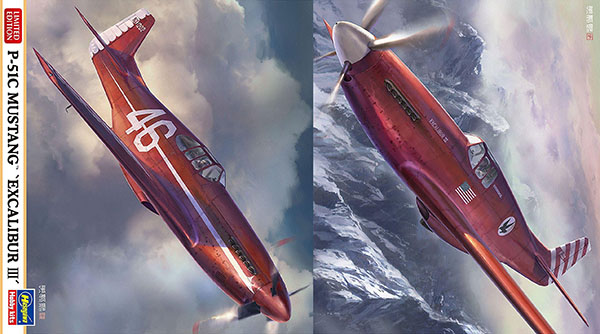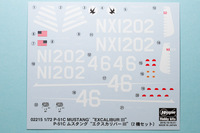
Hasegawa 1/72 P-51C "Excalibur III" Dual Combo
By Chris Banyai-Riepl
Overview
The bright red Excalibur III started out its post-war career as a Bendix racer owned by Paul Mantz. Mantz flew the plane in the 1946 and 1947 Bendix races, and set a transcontinental speed record with this plane (at the time called Blaze of Noon). In 1949, Mantz sold the plane to Charles Blair, who renamed the plane "Excalibur III" after the Sikorsky VS-44 he flew while with American Export Airlines. In 1951, Blair flew Excalibur III from New York to London in under eight hours, setting a new record. A few months later, in May 1951, Blair flew Excalibur from Norway to Alaska via the North Pole in just over 10 hours, setting another record. Blair's achievement came by plotting sun lines, as magnetic compasses were unreliable that far north.
As befitting such a record-setting aircraft, in 1953 Pan American Airlines purchased the plane from Blair and donated it to the National Air Museum. In 1977, the plane was completely restored and it is currently on display hanging over the wing of the Boeing 707 prototype.
The Kit
The Hasegawa 1/72 P-51B Mustang kit has been around for a while now, and has seen quite a few reboxings. Their latest resurrection of this kit has been in the form of dual combos, tossing two kits in one box with some interesting markings. Lately these markings have turned to air racers, which brings a new level of color to the Mustang. A previous dual combo kit had Jackie Cochran's green #13 Mustang and blue #90 Mustang as options. This one brings red to the field, with two variations of the famous Excalibur III P-51C Mustang.
As this is not the first dual combo P-51B/C reviewed here, and indeed not the first dual combo racing Mustang reviewed, I'll refer you to those other reviews for the overview of the plastic (and a full build of the kit as well), and focus instead on the markings. The original Excalibur III is currently on display at the Smithsonian National Air & Space Museum in Washington DC, so there is quite a bit known about the plane. In fact, that plane was the first subject in the superb Air & Space Museum publications that detailed the museum's restoration projects.

|
Given the amount of information that's available on the type, it looks like the overall research on the two options in the kit was done well. The early option is from Paul Mantz's 1946 Bendix race, which saw the plane finished in overall red with a white stripe, white numbers, and a white rudder with delicate red scalloping. As red is the predominant color, the decals are almost exclusively white, which includes the entire rudder as a decal. For this scheme, that is probably going to be the only real challenging spot, and some careful masking to ensure the edges are covered will be in order. My experience with Hasegawa's white decals hints at the potential for color bleed-through, though, so undercoating half of the rudder with white might not be an option here.
The second option is for Excalibur III, which was also finished in overall red, but with a white spinner. For this scheme there are white diagonal lines on the vertical fin and a diving bird emblem on the fuselage side, as well as the Excalibur III name on the nose. This plane also apparently had the rear teardrop windows replaced with sheet metal, and on these was written "Experimental", another detail the decals have correct. Overall, the decals are nicely printed with excellent detail on the fine text. Applying them down onto a red plane might tell a different story, though, so I hope that they double-printed the white on these.
Conclusion
While perhaps not the best 1/72 P-51B out there (is there actually a best one of these?), I can say that it builds up easily and looks every bit like a P-51B/C when done. The addition of colorful markings such as these will make this one stand out on the shelf, that's for sure. My thanks to Hasegawa USA for the review sample. Visit their site for all the upcoming Hasegawa releases.
